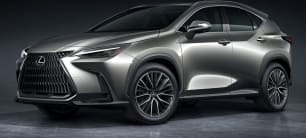The previous NX looked better than it drove.
Based on the previous-gen RAV4, it failed to rise above such humble underpinnings, despite all the extra design, comfort and equipment features Lexus created to help it do just that.
Sure, there were some very appealing things going on, including attractive styling, an intriguing interior, sumptuous seats and lots of kit to play with, but the Toyota's noisy, fidgety and tiring DNA soon became apparent, especially compared to rival luxury midsizers. And some of the dashboard multimedia controls were just down-right madness.
Building on the latest RAV4's set of modern, competent components, however, has fundamentally changed the NX.
For starters, it's much quieter inside. Whether at idle, travelling at speed, or traversing some pretty rough patches of road, the NX at last rides like something you'd expect a Lexus should. And given how noisy and droney most of its European rivals also are on Aussie bitumen, it gives the Japanese contender a handy head-start.
The same applies to how enveloping the soft yet supportive seats are, how settled the suspension feels and how calm the experience is. No previous Lexus SUV has seemed so... refined. Even the really big, expensive ones.
From the driver's point of view, the steering is beautifully balanced, for precise yet reassuring control at speed. This varies according to which grade you're driving, but as a whole, while not sporty like a BMW's nor as fluid as, say, a Mazda CX-5's helm, the Lexus walks that line between easy and involving quite well.
Ditto the handling and roadholding. The lightest of the bunch – the petrol-powered NX 250 and NX 350 turbo – feel ripe and ready for a hustle along a curvy ribbon of road, coming across as taut enough for tight turns yet supple enough to soak up the many bumps and thumps thrown up at them.
Switching to the NX 350h hybrid, there's a greater sense of mass, whether driving the front-drive 2WD or even heavier AWD version. As such, it's still quite dynamic, but not as athletic as the petrol-only models.
In terms of performance, there are no duds – and that's no surprise, as the previous NX's powertrains were pretty sound as well.
Though simply a front-drive version of the RAV4 Edge's 2.5-litre unit, the NX 250 seems more muted than the Toyota's application, and yet is willing to rev hard to hit the power band necessary for it to feel alive. At higher speeds, sometimes the raspy engine can sound a tad noisy when extended, but it's never harsh or rough.
Moving on to the NX 350h, it feels like, well, a heavier and quieter RAV4, not unexpectedly. Silent at take-off speeds, the engine chimes in fairly unobtrusively, providing plenty of oomph along the way, while the CVT seamlessly slices through each (artificial) ratios. After the petrol versions, the steering does seem a little more remote, and you can feel the extra heft through turns, but – again – the basics underneath seem right.
Accelerating hard on the open road does reveal that typical Toyota hybrid engine roar and CVT flair, but only when the throttle is prodded hard. Driven normally, the NX 350h is as smooth, swift and sweet as you'd expect. And definitely in keeping with brand performance expectations.
Finally, there's the NX 450h+ F Sport. At over two tonnes, Toyota and Lexus' plug-in hybrid debutante is not a flyweight by any means, yet having all that extra low-down mass does result in a slightly different driving experience.
Take acceleration: having access to 227kW of power and torque together at very low revs equals lots of thrust right from the get-go. And while it's not sports-SUV rapid, there's certainly enough punch to justify the F Sport badge. Similarly, the low centre of gravity that the 18.1kWh battery pack provides seems to promote hunkered-down road-holding attitude through tight turns, with minimal body roll.
Regardless of which NX you're looking at, quibbles are few. Occasional road and tyre roar are still a little evident over some surfaces; the adaptive cruise control and lane-keep technologies could benefit from some local fine-tuning so they behave a little more nuanced in Australian conditions (and that applies to most luxury SUVs nowadays); and the optional head-up display's capacitive controls located on the steering wheel spokes are distracting, difficult to modulate and needlessly complicated. They're so annoying we'd even untick the Sport Luxury option box to avoid it.
If we had to choose a favourite among the new NXs, it would probably be the NX 350h F Sport, since its adaptive sports chassis provides the best compromise between agility and suppleness; the NX 350 turbo is probably the most fun to drive hard and fast, while the base NX 250 is thoroughly competent and sufficiently luxurious to scare most rivals.
Could this really be a medium-sized Lexus SUV we're talking about?
We're not saying that the latest NX is perfect, but it now provides a very compelling argument not to buy European.
















.png)














































